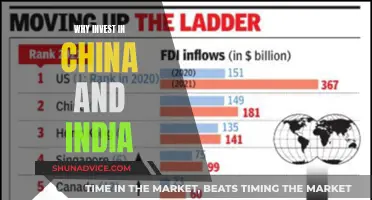
Benchmarks are a crucial tool in investing, often used as a reference point for the performance of securities, mutual funds, portfolios, and other financial instruments. A benchmark is a standard or measure used to analyse the allocation, risk, and return of a given portfolio. Investors use benchmarks to understand how their portfolio is performing against various market segments. While there are many types of benchmarks, the S&P 500 index is often used as a benchmark for equities, and U.S. Treasuries are used for measuring bond returns and risk.
A benchmark serves as a starting point for a portfolio manager to construct a portfolio and manage it on an ongoing basis, considering both risk and return. It allows investors to gauge the relative performance of their portfolios and provides a way to measure the value added by active managers and the investments that generated value.
However, most actively traded portfolios fail to beat their benchmark indices, especially after accounting for fees and taxes. This has led to the rise of passive investing, where investors opt for low-fee index funds instead of trying to beat the market. Despite this, some money managers claim they can beat market benchmarks, and certain individuals seem to have this skill.
So, how does an investment manager beat a benchmark? It requires skill, and perhaps a bit of luck, to identify and profit from mispriced securities in the stock market. It also involves understanding and selecting the appropriate benchmark, which should have a similar risk-return profile to the investment strategy or manager being evaluated.
| Characteristics | Values |
|---|---|
| Purpose of Benchmarks | To measure the change in an asset's value or another metric over time |
| Benchmarks in Investing | Used as a reference point for the performance of securities, mutual funds, exchange-traded funds, portfolios, or other financial instruments |
| Benchmarks as a Standard | Used to analyse the allocation, risk, and return of a given portfolio |
| Benchmarks as a Comparison Tool | Used to understand how a portfolio is performing against various market segments |
| Common Benchmarks | S&P 500, Dow Jones Industrial Average, Nasdaq 100, and more |
| Active Management | Requires selecting the appropriate benchmark to compare returns against |
| Passive Management | Investing in a passive fund is the primary way for a retail investor to invest in an index |
| Benchmarks and Risk | Used to monitor portfolios within the macro investing environment and identify opportunities for shifting investments |
| Benchmarks and Performance | Used to evaluate a portfolio's performance and identify areas for improvement |
| Benchmark Selection | Important to choose a benchmark that aligns with the investing universe and has similar risk-return profiles |
What You'll Learn

Using indexes to compare performance
Indexes are a valuable tool for investors to gauge the overall health of large public markets and to compare their own performance against a representative peer. Indexes are typically market indexes or a combination of indexes that investors and portfolio managers use to measure an investment portfolio's performance.
When used as a benchmark, indexes are an imaginary bucket of stocks held in a free portfolio with no trading costs and no capital gains taxes. This means that they are not subject to the same conditions as the investments in an investor's portfolio, making it harder for the investor to outperform them. However, they are still useful for investors to understand their performance relative to a representative peer.
There are a myriad of benchmarks to choose from, including traditional equity and fixed-income benchmarks, as well as more exotic benchmarks created for hedge funds, derivatives, real estate, and other types of investments. When selecting a benchmark, it is important to choose one that has a similar risk-return profile to the security, strategy, or manager in question.
Some examples of commonly used indexes include:
- S&P 500: This index lists 505 stocks based on specific metrics and valuation techniques that reflect the best-performing stocks on the stock market.
- Dow Jones Industrial Average: This index comprises 30 U.S. blue-chip stocks, or the stocks of well-recognized, established, and financially sound companies.
- Nasdaq 100: This index tracks the performance of the largest companies listed on the Nasdaq stock exchange.
- Bloomberg U.S. Aggregate Bond Index: This index tracks the performance of the largest bond issuers in the U.S.
- MSCI Indexes: These indexes are good benchmarks for international investors, showing performance across many international countries and regions.
It is important for investors to understand the underlying risks in a benchmark and their own risk tolerance when evaluating an index. Additionally, investors should be aware of the holdings in their portfolios compared to those in their chosen benchmarks to understand why their portfolios may perform differently.
Hong Kong Savings: Best Places to Invest Your Money
You may want to see also

The impact of fees and taxes
Fees and taxes can have a significant impact on an investment portfolio's performance and its ability to beat a benchmark.
Frictional Costs
Investors incur various frictional costs, such as trading costs, loads, commissions, and capital gains taxes. These costs are paid when investors enter, exit, or make changes to their investments within a fund or portfolio. Even when investors simply hold stocks, they may still incur frictional costs in the form of management and account fees. These costs can add up and eat into the returns generated by the portfolio, making it more challenging to outperform the benchmark.
Benchmark Indices Have No Frictional Costs
When popular benchmark indices like the S&P 500 are used for comparison, it's important to remember that they do not incur the same frictional costs as an actual investment portfolio. The S&P 500, for example, is an imaginary basket of stocks held in a free portfolio with no trading costs or capital gains taxes. This makes it more challenging for actively managed portfolios to outperform these benchmarks, as they operate under different conditions.
The Impact of Fees
Fees play a crucial role in the performance of actively managed funds. High fees can eat into the returns generated by the fund, reducing the overall profit for investors. This is why it is essential for investors to carefully consider the full expense ratio when researching mutual funds. A ratio exceeding 2% indicates a costly fund that puts investors at a disadvantage from the start.
Passive Investing and Low-Fee Index Funds
The impact of fees has led to the rise in popularity of passive investing and low-fee index funds. Vanguard, a prominent investment management firm, has built its success on the premise that the average investor is unlikely to beat the market and is better off investing in low-fee index funds. Their Total Stock Market index mutual fund, which tracks an index, has become the world's largest mutual fund. This approach acknowledges that high fees can hinder performance and make it more challenging for active managers to beat their benchmarks.
Taxes
Taxes also play a significant role in the performance of investment portfolios. Capital gains taxes, in particular, can impact the overall returns generated by a portfolio. While benchmarks do not incur these taxes, investors in actual portfolios must consider the impact of taxes on their returns. This further highlights the challenge faced by active managers in their attempt to beat the benchmark.
Maximizing Your Extra Savings: Smart Investment Strategies
You may want to see also

Choosing the right benchmark
- Risk-Return Profile: It is important to choose a benchmark with a similar risk-return profile to the investment or strategy being evaluated. This ensures that the analysis is accurate and reliable.
- Broad Market and Market-Segment Indexes: Broad market and market-segment stock and bond indexes are commonly used as benchmarks. These indexes provide a comprehensive view of the market and allow for a detailed analysis of specific segments.
- Investment Goals and Risk Tolerance: Investors should consider their investment goals and risk tolerance when selecting a benchmark. For example, an investor with a low-risk tolerance may choose an index with a shorter duration or higher credit quality. On the other hand, an investor seeking high returns may opt for an index with high long-term returns, even if it exhibits higher volatility.
- Liquidity Needs: The need for liquidity should also be considered when choosing a benchmark. Investors seeking to invest operating cash to meet short-term liabilities will require a highly liquid portfolio and a benchmark with a very short duration.
- International Securities: Whether or not an investor plans to invest in international securities can impact the choice of benchmark. Foreign currency exposure can affect portfolio value and volatility, so investors taking a position on currency may opt for an unhedged index, while those seeking capital preservation may prefer a hedged index.
- Inflation-Linked Liabilities: For investors with inflation-linked liabilities, such as fixed-income investors, choosing a benchmark that tracks inflation-indexed securities or inflation-benefiting assets like real estate and commodities may be prudent.
- Diversification and Asset Allocation: A benchmark should allow for diversification and proper asset allocation. A broad investment universe can help increase returns and reduce volatility. However, if the benchmark is too narrow, it may hinder the investment manager's ability to significantly impact the portfolio's performance.
- Benchmark Standards: When selecting a specific benchmark, it is essential to consider minimum standards. These include unambiguous and transparent security selection, investability, daily pricing, historical data availability, low turnover, advance specification, and published risk characteristics.
By carefully considering these factors, investors and investment managers can choose the right benchmark to effectively evaluate the performance of their portfolios and make informed investment decisions.
Scion Asset Management: Investing in the Right Direction
You may want to see also

Active vs passive investing
Active investing involves selecting and overseeing a group of investments that meet a client's long-term financial objectives and risk tolerance. Active managers seek to beat the market and claim they can beat market benchmarks, with some touting impressive track records. However, most actively traded portfolios fail to beat their benchmark indices, especially after accounting for fees and taxes.
Passive investing, on the other hand, involves investing in index funds, which are a type of investment fund that tracks the performance of a specific market index, such as the S&P 500. Passive investing is based on the premise that it is difficult to consistently beat the market, so investors are better off investing in a diversified portfolio of index funds with low fees. Passive investing has gained popularity in recent years, with firms like Vanguard amassing trillions of dollars in investor assets by offering low-cost index funds.
The debate between active and passive investing has been a long-standing one. Proponents of active investing argue that skilled fund managers can identify and profit from mispriced securities, resulting in market-beating returns. They also argue that active management allows for more flexibility and the potential for higher returns. On the other hand, supporters of passive investing believe that the average investor is unlikely to beat the market consistently and that the fees associated with active management eat into any potential gains.
So, which approach is better? The answer may depend on various factors, including an investor's risk tolerance, investment goals, and time horizon. Active management may be suitable for investors with a high-risk appetite and the desire to actively time the market. In contrast, passive investing may be more appropriate for those seeking a more hands-off approach and long-term wealth accumulation.
Ultimately, the decision between active and passive investing comes down to an investor's individual preferences, financial situation, and investment objectives. Both approaches have their advantages and disadvantages, and it is essential to carefully consider the risks and potential rewards associated with each before making any investment decisions.
Understanding FAFSA's Treatment of Investments and Bank Accounts
You may want to see also

The role of luck vs skill
The role of luck versus skill in an investment manager beating a benchmark is a highly debated topic. While some argue that it is purely down to luck, others believe that skill plays a significant part. So, what does the evidence suggest?
Firstly, it is important to understand the concept of a benchmark. A benchmark is a standard or measure used to analyse and compare the performance of an investment portfolio. Common benchmarks include the S&P 500, Dow Jones Industrial Average, and the Nasdaq 100. These indexes provide a reference point for investors to gauge how well they are performing relative to the market.
Now, let's examine the arguments for luck and skill. Proponents of the luck argument, including academics from the University of Chicago Booth School of Business, suggest that professional stock pickers who beat the market are simply lucky rather than more skilled. This argument has fuelled the growth of passive investing, where investors opt for low-fee index funds that track a market index rather than trying to beat the market. In support of this argument, it is noted that most actively traded portfolios fail to beat their benchmark indices, especially after considering fees and taxes.
On the other hand, supporters of the skill argument, such as Lubos Pastor from Chicago Booth, believe that money managers possess skill and are becoming increasingly more skilled over time. Jonathan Berk and Richard C. Green, in a 2004 paper, suggested that an individual manager can have skill and can beat the market by an average of 6.5 percentage points. They further argued that maintaining market-beating performance is challenging due to increased assets under management and the resulting impact on stock prices.
So, which is it? Luck or skill? The answer may lie in a combination of both factors. While it is true that many money managers fail to beat the market, there are some who consistently outperform the benchmarks. This could be attributed to their skill and expertise in identifying and profiting from mispriced securities. However, it is important to consider that even skilled managers may struggle to maintain their performance due to increased competition and the challenges of managing larger funds.
In conclusion, while luck may play a role in the short term, skill and expertise are more likely to be the determining factors in the long run. Investment managers who possess a deep understanding of the market, stay updated with the latest knowledge and technology, and make prudent investment decisions are more likely to beat the benchmarks consistently.
Investment Management Fees: Are They Deductible on Form 1041?
You may want to see also
Frequently asked questions
A benchmark is a standard or measure used to analyse the allocation, risk, and return of a given portfolio. It is a reference point for the performance of securities, mutual funds, exchange-traded funds, portfolios, or other financial instruments.
Most fund managers fail to beat market benchmarks due to various factors such as competition, increased assets under management, and high fees and taxes. As the industry grows, competition increases, making it harder for managers to outperform. Additionally, as investors recognise a manager's skill, they place more assets under their management, making it harder to maintain market-beating performance.
Benchmarks provide a starting point for portfolio managers to construct and manage portfolios based on risk and return. They allow investors to gauge the relative performance of their portfolios and make informed investment decisions. Benchmarks also help investors understand the overall health of the market and the assets they comprise.
An investment manager can beat a benchmark by generating returns that exceed the benchmark's performance, taking into account fees and taxes. This requires skill, effective strategies, and a thorough understanding of the market and the specific benchmark being used.
Common benchmarks include the S&P 500, Dow Jones Industrial Average, Nasdaq 100, and the Bloomberg U.S. Aggregate Bond Index. These benchmarks track the performance of various market sectors and provide a reference point for investors to compare their portfolio's performance.







